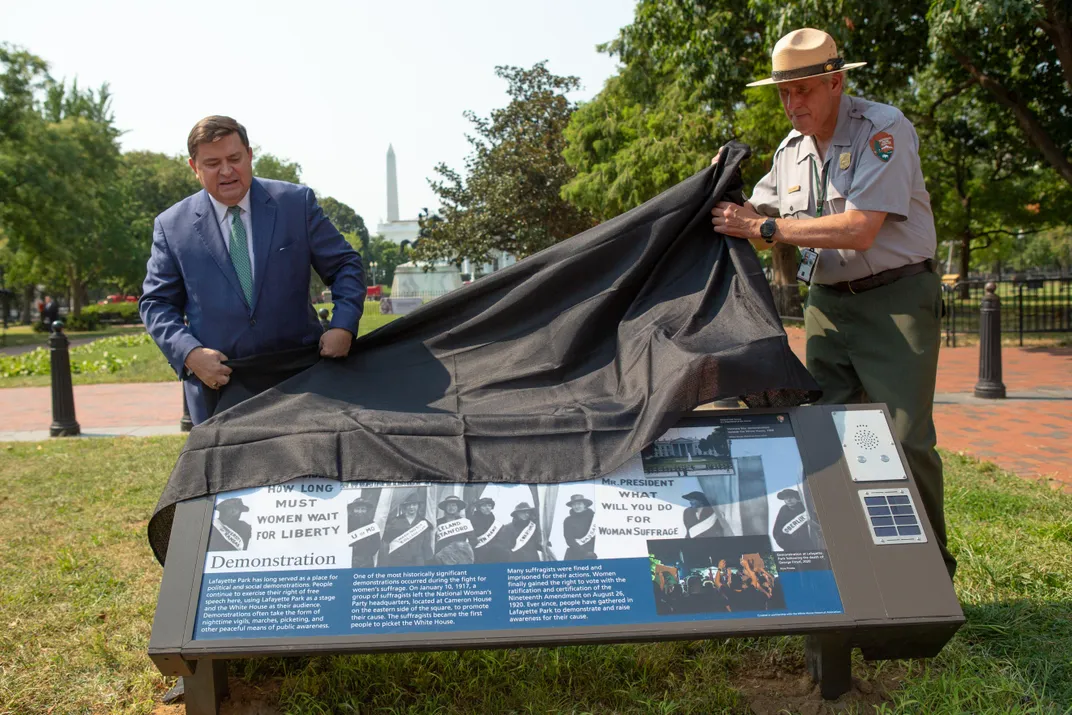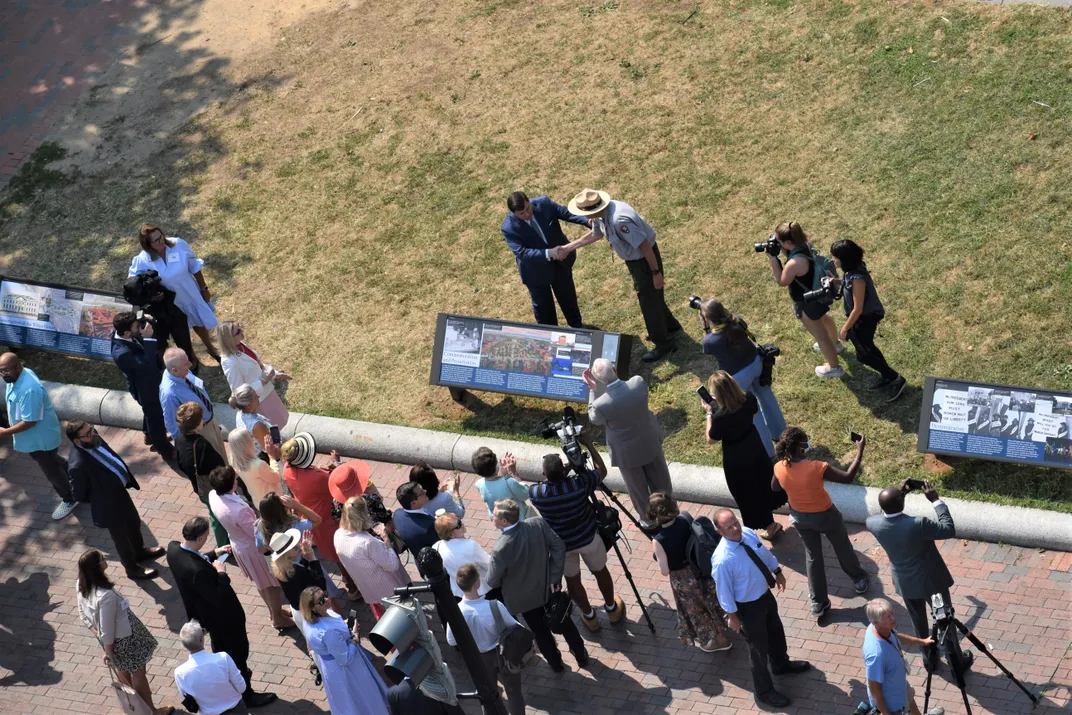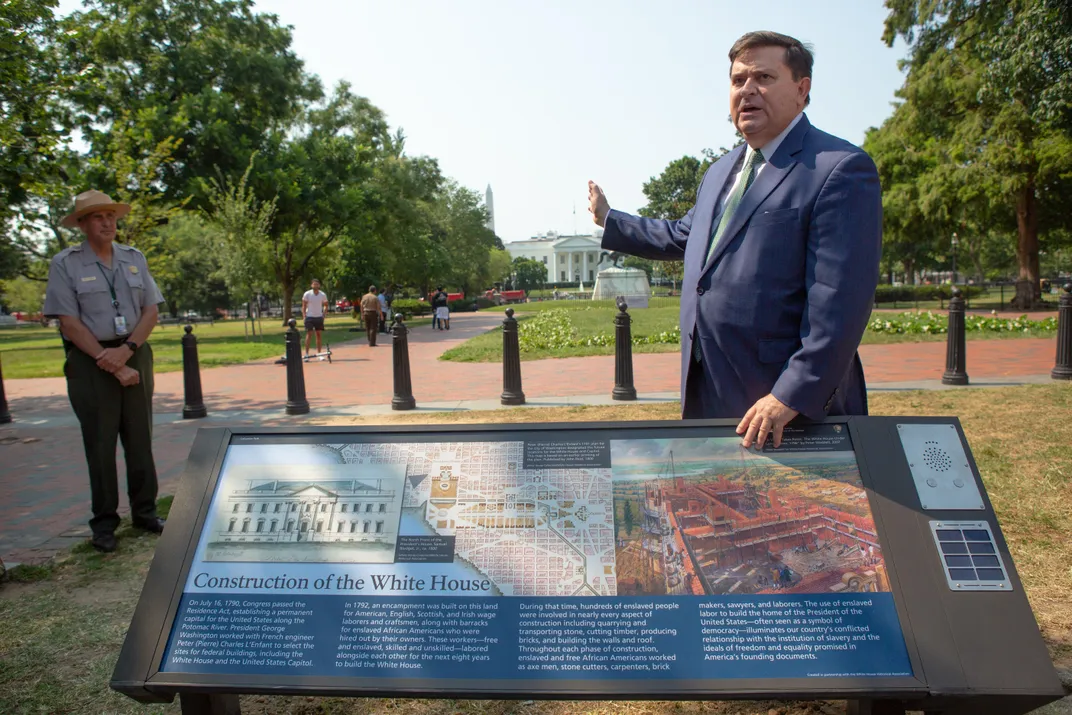New Plaque Tells Story of Enslaved People Who Helped Build the White House
A marker in Lafayette Square is the first public work to acknowledge these individuals’ roles in constructing the presidential mansion
:focal(3584x3136:3585x3137)/https://tf-cmsv2-smithsonianmag-media.s3.amazonaws.com/filer/4a/6d/4a6d9f18-bf95-42ff-9ef8-915dd4f78732/6q6a0093.jpg)
A new plaque facing the White House bears witness to a shameful chapter in United States history: when enslaved people helped build one of the nation’s seats of government. Unveiled in a ceremony last week, the sign is one of three informational markers that now stand at the northern entrance of Lafayette Square in Washington, D.C.
Conceived by the White House Historical Association (WHHA) in collaboration with the National Park Service (NPS), the center and rightmost signs discuss Jackie Kennedy’s role as the WHHA’s founder and the history of protests in Lafayette Square, respectively, per a statement.
But the leftmost marker is the most notable, as it explains how enslaved people aided the White House’s construction. Though small, the signs marks the first time that a public work has formally acknowledged the role that enslaved people played in the creation of the U.S.’ most iconic building, reports Joe Heim for the Washington Post.
Free and enslaved Black people worked alongside white laborers and craftsmen at the site between 1792 and 1800. As the sign attests, “hundreds of enslaved people were involved in nearly every aspect of construction including quarrying and transporting stone, cutting timber, producing bricks, and building the walls and roof.”
The marker continues, “The use of enslaved labor to build the home of the President of the United States—often seen as a symbol of democracy—illuminates our country’s conflicted relationship with the institution of slavery and the ideals of freedom and equality promised in America’s founding documents.”
This eight-year construction project is just one of the White House’s many links to slavery. Enslaved people helped rebuild the mansion after it was set on fire by British troops in 1814; generations of enslaved people also lived in the White House and worked for nine presidential households, including those of Thomas Jefferson, James Madison, James Monroe, John Quincy Adams, Andrew Jackson, Martin Van Buren, John Tyler, James K. Polk and Zachary Taylor.
Lafayette Park, the site of the new informational markers, was once bordered by “slave pens,” where enslavers held Black people in bondage before selling them into slavery—all within view of the U.S. Capitol, as DeNeen L. Brown wrote for the Washington Post last year.
Though historians have long noted disturbing links between the U.S. presidential mansion and slavery, these stories often received little mainstream attention. Then, in 2016, First Lady Michelle Obama brought the issue into the spotlight at the Democratic National Convention, noting, “I wake up every morning in a house built by slaves.”
Obama’s remarks unleashed a flood of inquiries from people who wanted to know more. Many reached out to the WHHA, as the organization’s president, Stewart McLaurin, tells NPR’s Elliot Williams.
This outpouring of interest inspired “Slavery in the President’s Neighborhood,” an ongoing WHHA research project available to explore online. So far, the team has identified the names of more than 300 enslaved people who helped build the White House or labored for the First Families, as Heim reported for the Washington Post last year. (Anyone who might have relevant information for the researchers is encouraged to contact the organization via email at [email protected].)
Essays on the WHHA’s website include detailed information about enslaved people, including Paul Jennings, who served as President Madison’s valet, and 14-year-old Ursula Granger Hughes, who gave birth to the first child born in the White House, a boy likely named Asnet, in either 1801 or early 1802.
The project’s goal, says McLaurin, is to learn as much as possible about these overlooked White House residents by piecing together newspaper clippings, oral histories, census records and other sources.
“We knew that enslaved people had helped build the White House,” the director tells NPR. “But … what can we find out about who they were? What can we find out about what they did, where they came from, what were their roles?”
/https://tf-cmsv2-smithsonianmag-media.s3.amazonaws.com/accounts/headshot/nora.png)



/https://tf-cmsv2-smithsonianmag-media.s3.amazonaws.com/accounts/headshot/nora.png)